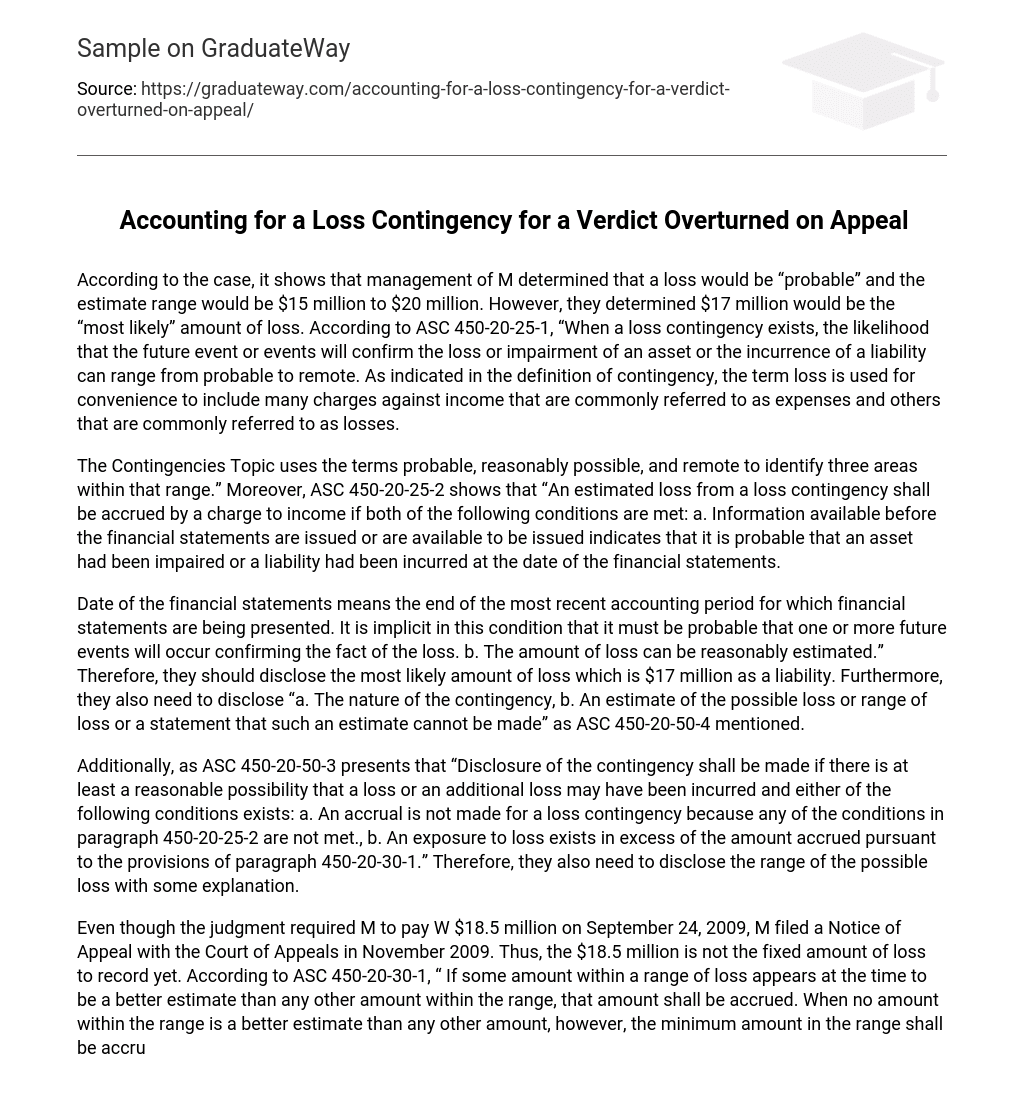According to the case, it shows that management of M determined that a loss would be “probable” and the estimate range would be $15 million to $20 million. However, they determined $17 million would be the “most likely” amount of loss. According to ASC 450-20-25-1, “When a loss contingency exists, the likelihood that the future event or events will confirm the loss or impairment of an asset or the incurrence of a liability can range from probable to remote. As indicated in the definition of contingency, the term loss is used for convenience to include many charges against income that are commonly referred to as expenses and others that are commonly referred to as losses.
The Contingencies Topic uses the terms probable, reasonably possible, and remote to identify three areas within that range.” Moreover, ASC 450-20-25-2 shows that “An estimated loss from a loss contingency shall be accrued by a charge to income if both of the following conditions are met: a. Information available before the financial statements are issued or are available to be issued indicates that it is probable that an asset had been impaired or a liability had been incurred at the date of the financial statements.
Date of the financial statements means the end of the most recent accounting period for which financial statements are being presented. It is implicit in this condition that it must be probable that one or more future events will occur confirming the fact of the loss. b. The amount of loss can be reasonably estimated.” Therefore, they should disclose the most likely amount of loss which is $17 million as a liability. Furthermore, they also need to disclose “a. The nature of the contingency, b. An estimate of the possible loss or range of loss or a statement that such an estimate cannot be made” as ASC 450-20-50-4 mentioned.
Additionally, as ASC 450-20-50-3 presents that “Disclosure of the contingency shall be made if there is at least a reasonable possibility that a loss or an additional loss may have been incurred and either of the following conditions exists: a. An accrual is not made for a loss contingency because any of the conditions in paragraph 450-20-25-2 are not met., b. An exposure to loss exists in excess of the amount accrued pursuant to the provisions of paragraph 450-20-30-1.” Therefore, they also need to disclose the range of the possible loss with some explanation.
Even though the judgment required M to pay W $18.5 million on September 24, 2009, M filed a Notice of Appeal with the Court of Appeals in November 2009. Thus, the $18.5 million is not the fixed amount of loss to record yet. According to ASC 450-20-30-1, “ If some amount within a range of loss appears at the time to be a better estimate than any other amount within the range, that amount shall be accrued. When no amount within the range is a better estimate than any other amount, however, the minimum amount in the range shall be accrued.
Even though the minimum amount in the range is not necessarily the amount of loss that will be ultimately determined, it is not likely that the ultimate loss will be less than the minimum amount.” Moreover, ASC 250-10-45-17 presents that “A change in accounting estimate shall be accounted for in the period of change if the change affects that period only or in the period of change and future periods if the change affects both. A change in accounting estimate shall not be accounted for by restating or retrospectively adjusting amounts reported in financial statements of prior periods or by reporting pro forma amounts for prior periods.” Therefore, they should adjust the liability to $18.5 million and a 2009 event only.
In December 2010, the Court of Appeals overturned the jury verdict and the $18.5 million judgment against M. However, on January 6, 2011, W filed a petition for a re-hearing before the same panel of appellate judges against the reversal of ruling by Court of Appeals. According to ASC 855-10-25-1, “An entity shall recognize in the financial statements the effects of all subsequent events that provide additional evidence about conditions that existed at the date of the balance sheet, including the estimates inherent in the process of preparing financial statements.” Additionally, ASC 450-10-05-5 presents that “Resolution of the uncertainty may confirm any of the following: b. The reduction of a liability”.
Furthermore, ASC 450-30-25-1 shows that “A contingency that might result in a gain usually should not be reflected in the financial statements because to do so might be to recognize revenue before its realization.” Therefore, because of the subsequent event in the period preparing financial statements, M cannot record the reduction of the previously recorded loss contingency in 2010. However, since the appellate judges declined the petition for a re-hearing on February 10, 2011, M can record the reduction of the loss contingency in 2011.





